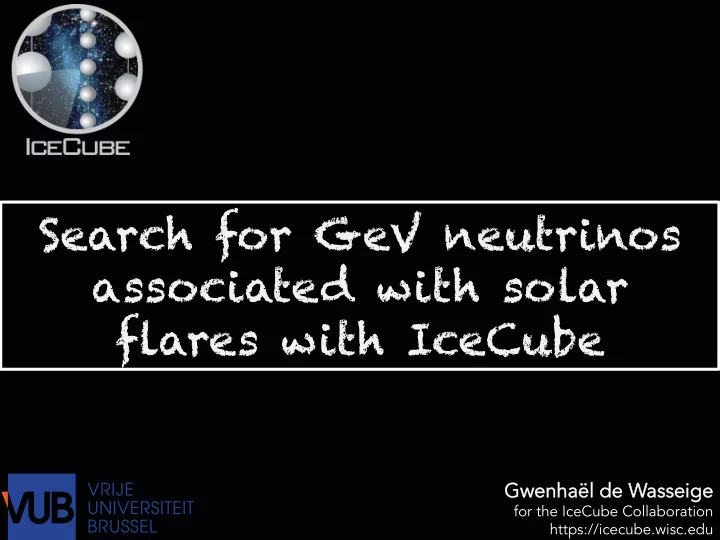

Search for GeV neutrinos associated with solar flares with IceCube Gwenhaël Gwenhaël de W de Wasseige asseige for the IceCube Collaboration https://icecube.wisc.edu
I am about to tell you: • How we can use the IceCube neutrino observatory as a GeV neutrino detector • Why solar flares are ideal candidates for this event selec;on 2
Extracting GeV neutrinos • Selec;ng neutrinos with E < 5GeV • Searching for an enhancement in the event rate during an astrophysical transient event 3
6
Extracting GeV neutrinos - Select the filters - Remove HE events - Try to remove noise 7
IceCube 8
IceCube DeepCore 9
Extracting GeV neutrinos - After filter selection Data 16 Hz Pure 7 Hz Noise 99.8 % Signal * * = Neutrinos < 5GeV with E -2 spectrum
Extracting GeV neutrinos ü Select the filters - Remove HE events - Try to remove noise 11
What is the difference? 15
How many Hard Local Coincidences ? 16
17
Are they causally connected? 18
Extracting GeV neutrinos ü Select the filters - Remove HE events N HLC-DOMS in IceCube strings ≤ 6 N HLC-DOMS in DeepCore strings ≤ 7 N DOMS causally connected ≤ 10 19
Extracting GeV neutrinos ü Select the filters ü After removing HE events 6.79 Hz Data Pure 6.49 Hz Noise Signal 99.0 % 20
21
e s i o n l a m r e h t d e t a l e r r o c Uncorrelated radioactive noise n U e s i o n n o i t a l l i t n i c s d e t a l e r r o C 22
e s i o n l a m r e h t d e t a l e r r o c Uncorrelated radioactive noise n U e s i o n n o i t a l l i t n i c s d e t a l e r r o C è Causality between hits è (;me window, threshold, velocity) 23
Extracting GeV neutrinos ü Select the filters ü Remove HE events - Try to remove noise 0.22 Hz Data Pure 0.11 Hz Noise Signal 57.0 % 24
Extracting GeV neutrinos ü Select the filters ü Remove HE events ü Try to remove noise Sensitive to 0.22 Hz Data SF! Pure 0.11 Hz Noise Signal 57.0 % 25
n γ Solar flare ν , ν what? p + p ¤ atm è π + è μ + + ν μ μ + è e + + ν e + ν μ π 0 è 2 γ hadron acceleration (up to π - è μ - + ν μ several GeV) μ - è e - + ν e + ν μ p, α … = Solar Energetic Particles 26
n γ Solar flare ν , ν what? p + p ¤ atm è π + è μ + + ν μ μ + è e + + ν e + ν μ π 0 è 2 γ hadron acceleration (up to π - è μ - + ν μ several GeV) μ - è e - + ν e + ν μ p, α … = Solar Energetic Particles 27
Solar flare ν , how? Sun IceCube ν γ i m r e F
Solar flare ν , how? Fermi light curve for March 7 th , 2012 29
Solar flare ν , how? 20 minutes Fermi light curve for March 7 th , 2012 30
Solar flare ν , why? If detec;on: Confirmation of hadronic acceleration in solar flares If no detec;on: Strongest limit on Sf ν flux In any case: Constraint on the proton acceleration 31
Beam of protons: F(E) = A E -δ H(E max – E) A and δ derived from observa;ons Fixed δ = 3.2 yield per injected proton htemp htemp E = 7GeV max Entries 341404 Entries 341404 2 − 10 Mean 0.08654 Mean 0.08654 Std Dev 0.1026 Std Dev 0.1026 E = 3GeV max − 3 10 4 − 10 ν 5 − 10 Average 6 − 10 − 7 10 0 0.5 1 1.5 2 2.5 3 Neutrino energy (GeV) 32
Solar flare ν , why? Fixed δ = 3.2 - March 7 th , 2012 - Impulsive phase - 20 minutes - 0.22Hz of data 33
Take-home messages • IceCube is sensi;ve to GeV neutrinos from transient sources • We can constrain solar flare physics Thanks!
Extracting GeV neutrinos - Select the filters Low-Up AOF * DeepCore CascadeFilter MuonFilter VEF … Full Sky Starting 36 * AOF = Any Other Filter
Extracting GeV neutrinos è Causality between hits 3 parameters: - time window (ns) - velocity (m/ns) - threshold (#of pairs) 37
38
Geant4 simulation • beam of protons of F(E) = A E -δ H(E max – E) A and δ derived from observa;ons 39
Geant4 simulation • beam of protons of F(E) = A E -δ H(E max – E) A and δ derived from observa;ons • Coupling with Fermi observa;ons: (δ, E max ) 40
Recommend
More recommend